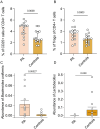Sex-dependent modulation of T and NK cells and gut microbiome by low sodium diet in patients with primary aldosteronism
- PMID: 39749333
- PMCID: PMC11693743
- DOI: 10.3389/fimmu.2024.1428054
Sex-dependent modulation of T and NK cells and gut microbiome by low sodium diet in patients with primary aldosteronism
Abstract
Background: High dietary sodium intake is a major cardiovascular risk factor and adversely affects blood pressure control. Patients with primary aldosteronism (PA) are at increased cardiovascular risk, even after medical treatment, and high dietary sodium intake is common in these patients. Here, we analyze the impact of a moderate dietary sodium restriction on microbiome composition and immunophenotype in patients with PA.
Methods: Prospective two-stage clinical trial including two subgroups: 15 treatment-naive PA patients compared to matched normotensive controls; and 31 PA patients on mineralocorticoid receptor antagonist treatment before and three months after sodium restriction. Patients underwent blood pressure measurements, laboratory tests, analysis of peripheral blood mononuclear cells via flow cytometry and microbiome analysis.
Results: We observed a higher percentage of Tregs in treatment-naive PA patients (p = 0.0303), while the abundance of Bacteroides uniformis was higher in PA patients compared to normotensive controls (p = 0.00027) and the abundance of Lactobacillus species however was higher in the subgroup of normotensive controls (p = 0.0290). Sodium restriction was accompanied by a decrease in pro-inflammatory Tc17 cells in male patients (p = 0.0081, females p = 0.3274). Bacteroides uniformis abundance was higher in female patients (0.01230, p = 0.0016) and decreased upon sodium restriction (0.002309, p = 0.0068).
Conclusion: Dietary sodium restriction in patients with PA modulates the peripheral immune cell composition toward a less inflammatory phenotype. This suggests a potential mechanism by which sodium reduction modulates immune cell composition, leading to blood pressure reduction and positively impacting cardiovascular risk.
Keywords: Tc17; Tregs (regulatory T cells); microbiome; primary aldosteronism (PA); sodium.
Copyright © 2024 Nowotny, Zheng, Seiter, Ju, Schneider, Kroiss, Sarkis, Sturm, Britz, Lechner, Potzel, Kunz, Bidlingmaier, Neuhaus, Gottschlich, Kobold, Reisch, Schirmer, Reincke and Adolf.
Conflict of interest statement
SKo has received honoraria from TCR2 Inc, Novartis, BMS, Miltenyi and GSK. SKo is an inventor of several patents in the field of immuno-oncology. SKo received license fees from TCR2 Inc. and Carina Biotech. AG received research support from Tabby Therapeutics for work unrelated to the manuscript. SKo received research support from TCR2 Inc., Plectonic GmBH, Catalym GmbH, and Arcus Bioscience for work unrelated to the manuscript. The remaining authors declare that the research was conducted in the absence of any commercial or financial relationships that could be construed as a potential conflict of interest.
Figures




References
-
- Powles J, Fahimi S, Micha R, Khatibzadeh S, Shi P, Ezzati M, et al. . Global, regional and national sodium intakes in 1990 and 2010: a systematic analysis of 24 h urinary sodium excretion and dietary surveys worldwide. BMJ Open. (2013) 3:e003733. doi: 10.1136/bmjopen-2013-003733 - DOI - PMC - PubMed
Publication types
MeSH terms
LinkOut - more resources
Full Text Sources

